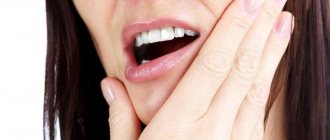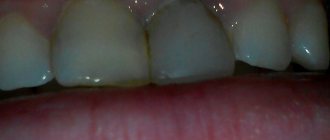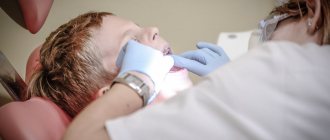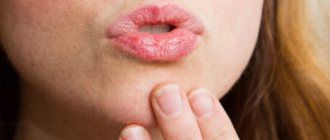Swelling of the upper lip in a child indicates the development of pathological processes in the body that require mandatory treatment.
This article discusses the main causes, symptoms and treatment methods depending on the etiology of edema. Possible complications and prevention of this condition in a child are also described.
Why is my child's upper lip swollen?
A swelling on a child’s lip cannot occur on its own. This signals the emergence of some problems that affect the baby’s health.
To prevent them, it is important to correctly and timely identify the factors that provoked swelling.
Among them, experts highlight:
- It is important to correctly and timely identify the factors that provoked swelling
Allergy, as a reaction to certain foods , oral hygiene products. This is also how the body can react to taking certain medications or the presence of orthodontic structures in the mouth.
- Insect bites provoke swelling of the mucous membranes of the lips, as a result of individual allergies.
- Teething may be accompanied by slight swelling of the baby's lips.
- Traumatic injury. In addition to mechanical damage, a swollen lip in a child can cause frostbite, chapping, or burns.
- Pathologies of systemic viral, infectious or bacterial origin. Most often, the body reacts this way to ARVI, herpes infection, or acute respiratory infections.
- Dental diseases: periodontal disease, stomatitis of any etiology, periodontal disease, periostitis.
- Dentist mistakes. Incorrect treatment or poor quality dental procedures can cause lip swelling.
- Inflammation. This symptom is characteristic of many diseases, or may be a response to a lip injury.
Important! If the swelling of the lip is caused by an inflammatory process, then the presence of accompanying symptoms is mandatory. This may include hyperthermia, soreness and a change in color. Also, depending on the etiology, ulcers may appear on them. - The habit of biting your lip provokes constant mechanical damage, which becomes the main cause of the formation of microcracks and wounds with subsequent infection.
- Hygiene problems. Children begin to learn about the world through their mouths, so it is impossible to maintain proper hygiene of the oral cavity and all objects that the baby puts into his mouth. The entry of bacteria into the mouth provokes the development of inflammatory processes, which can cause the lip to swell.
Other causes of upper lip swelling in children
In addition to dental diseases, there are a number of other diseases and conditions that lead to the pathology in question:
- allergic reaction to an irritant (animal fur, certain foods, toothpaste);
- mechanical damage to the lip (impact, biting);
- furunculosis (first a tumor forms, and only after 1–2 days it will be possible to visually determine the location of the formation of a purulent focus).
Non-pathological causes include teething at an early age (the child simply injures the delicate mucous membrane on the inside of the lip with sharp edges), and an insect (mosquito) bite.
Symptoms
In medical practice, swelling on the lips can be localized in any area. Most often in children, its upper part swells. But, regardless of where the swelling is located, this condition can be a sign of a life-threatening condition.
The appearance of swelling on the upper lip, depending on the etiology, may be accompanied by the following symptoms:
- Regardless of where the swelling is located, these symptoms may be a sign of a life-threatening condition.
The anatomical shape of the lips changes.
- Rapid and sudden development of a tumor.
- The appearance of swelling of the mucous membranes of the tongue and oral cavity.
- There is an unpleasant odor from the mouth.
- Increased pain on palpation of the lip and area under the nose.
- Labored breathing.
- Itching sensation on the lips, throat or mouth.
- The skin began to darken and acquire a blue tint.
- High body temperature, chills, fever.
- Sensation of a foreign object in the throat.
- There may be small pimples and blisters on the lips.
Important! If a child shows the slightest sign of swelling on the upper lip, it is necessary to immediately seek qualified medical help. The specialist will be able to correctly determine the cause of swelling and prescribe appropriate treatment to stabilize the child’s condition.
Associated symptoms and what do they indicate?
In addition to the main symptoms, swelling of the lips in a child is always accompanied by additional symptoms.
According to the accompanying manifestations, the diagnosis is made easier:
| Sign | What does it indicate? |
| Temperature | The development of both general and local hyperthermia indicates an infectious etiology of the disease and the appearance of inflammation. |
| Only the middle of the lip is swollen | The formation of an abscess as a result of mechanical trauma to the soft tissues and pulp of the tooth. |
| My lip is very swollen | For the occurrence of an allergic reaction in the form of Quincke's edema, disruption of the functionality of the salivary glands, or severe injury and insect bites. |
| Swollen lower lip | For the appearance of neoplasms of various etiologies, the development of angioedema or allergic edema. And also for mechanical injury to the integrity of the lip. |
| The lip is festering | This sign is a symptom of bacterial infection of the oral cavity, the development of purulent stomatitis, cheilitis, type 1 herpes, or the presence of closed acne. |
Important! Regardless of the visual signs, to make an accurate diagnosis it is necessary to undergo a full examination, which includes laboratory testing.
Why do lips swell?
Mechanical reasons
Various mechanical impacts are one of the most common causes of lip swelling.
The symptom appears as a result of a fall or an accidental or intentional blow to the face. It is characterized by an asymmetry of location, the presence of hematomas and abrasions. Minor injuries with minor local swelling of one lip are the result of damage from a toothpick or dental floss. In some people, swelling occurs as a result of constant self-harm - the habit of biting the lip. Lip burns are usually superficial; in addition to swelling, hyperemia, pain, and sometimes peeling and crust formation are observed. Thermal burns are detected after ingestion of too hot liquids and food, or contact of lips with heated dishes. After prolonged exposure to the sun, sunburn is possible. Chemical burns are often severe and are caused by accidental or intentional use of aggressive substances.
In the summer, the lip may swell due to an insect bite. In women, the symptom often occurs as a result of cosmetic procedures: piercing, tattooing, contouring. Significant swelling of the lips is observed in the first days after plastic surgery: lipofilling, VY plastic surgery, lip shape correction.
Allergic reactions
Allergic cheilitis is most often observed when using lipstick. Other possible cosmetic allergens are contour pencils, lip creams, and toothpastes. Sometimes lip swelling is caused by dentures. Among food products, contact allergies are caused by citrus fruits, pineapples, and some berries.
Chemical industry workers and musicians who use mouthpieces when playing wind instruments may develop occupational allergic reactions. Swelling of the lips may be due to an allergy to an insect bite, which is different from the usual reaction caused by irritants entering the tissue.
Allergic cheilitis is manifested by burning, itching, swelling, redness of the lips against the background of limited erythema at the site of contact with the allergen. Nearby tissues usually remain intact; in some cases, swelling is observed to spread to the oral mucosa and surrounding skin. A more severe form of allergy is considered to be Quincke's edema, in which swelling diffusely spreads to the face, lips, oral mucosa, tongue, pharynx, and larynx.
Atopic cheilitis, which is one of the signs of neurodermatitis, is characterized by a chronic course with seasonal exacerbations. Allergens include medications, pollen, household dust, food products, etc. The first manifestations are swelling and hyperemia, always limited to a red border. Then erythema, peeling, grooves and cracks appear.
Swelling of the lips
Other types of cheilitis
Inflammation of the red border of the lips is accompanied by swelling, redness, peeling, pain and burning. Sometimes complicated by the formation of bleeding ulcers and purulent crusts. Can be caused by the following forms of cheilitis:
- Exfoliative.
Develops against the background of neurotic disorders, hyperfunction of the thyroid gland. Initially, superficial scales appear on swollen lips. Over time, rough, dense crusts form. - Glandular.
Caused by the proliferation of minor salivary glands due to congenital structural features or dental diseases. Swelling and dryness are complemented over time by the formation of deep cracks. - Meteorological.
Associated with increased sensitivity to cold, wind, and ultraviolet radiation. Against the background of swelling, itching, burning, erosions and crusts appear. With a long course, the development of precancerous diseases and lip cancer is possible. - Hypovitaminosis.
It is observed in people with a deficiency of B vitamins, especially -. Slight swelling and hyperemia affect the lips, mucous membranes of the mouth and tongue.
Dental diseases
In dental pathologies, swelling spreads to the lips from adjacent soft tissues and is localized mainly along their inner surface.
- Oral candidiasis.
Hyperemia, swelling and a white cheesy coating are detected on the mucous membrane of the cheeks, lips, palate, and back of the tongue. With the development of candidal cheilitis, maceration, superficial peeling, and the formation of grayish films and crusts are observed. - Stomatitis.
More often the lower lip swells. With catarrhal stomatitis, the swelling is insignificant; with aphthous, ulcerative, ulcerative-necrotic stomatitis, the swelling is more pronounced if the ulcers are located close to the lips, and may be asymmetrical. - Periostitis.
The swelling is one-sided, spreading to the lips from the cheek, accompanied by intense pain and limited jaw movements. - Salivary stone disease.
Swelling of the lower lip occurs when the salivary gland is blocked by a large stone and is a consequence of reactive inflammation.
Viral and bacterial infections
A common cause of asymmetrical limited swelling of the lip is the herpes virus. First, the patient feels a burning sensation, itching, and local swelling. Then a group of bubbles forms in the affected area, which after a few days subside to form a self-falling crust. The pathology is prone to a recurrent course; exacerbations are caused by acute infections, hypothermia, overheating, and decreased immunity.
Erysipelas occurs when infected with beta-hemolytic streptococcus, and is more often detected in patients suffering from caries, diseases of the oral cavity, and diseases of the ENT organs. Swelling is one of the first symptoms of erysipelas; it occurs on the lip, nearby mucous membranes or skin. Accompanied by severe symptoms of intoxication. Then erythema and regional lymphadenitis appear. Subsequent relapses are possible.
Tumors
Swelling is not typical for lip papillomas; it appears when the formations are traumatized. With keratoacanthoma, local swelling may be found around the central funnel filled with horny masses. Manganotti cheilitis at the initial stage is manifested by local edema, hyperemia of the lip, in the area of which an irregularly shaped erosion forms. Subsequently, swelling is absent or slightly expressed. In case of lip cancer, swelling is more often found in patients with an ulcerative form of the disease, when the tumor disintegrates.
Rare pathologies
Rare causes of the symptom include Melkersson-Rosenthal syndrome, accompanied by recurrent swelling of the lips. During an exacerbation, the lips enlarge 2-3 times, become dense, bluish-elastic, and turn out, exposing the mucous membrane. Swelling of neighboring areas is possible: cheeks, eyelids, tongue. Other signs are facial neuritis and folded tongue.
Other reasons
Swelling of the lips and face can be observed in acute infectious diseases and other conditions accompanied by general hyperthermia. Another possible cause of swelling of diffuse swelling, including in the lip area, is somatic pathologies with fluid retention. Sometimes swelling is observed against the background of hypothermia or, conversely, exposure to high ambient temperatures.
Diagnostics
To make an accurate diagnosis and identify the causes of the disease in case of swelling of the upper lip in a child, it is necessary to undergo a timely medical examination.
If rapid swelling occurs, you must urgently call an ambulance or consult an allergist yourself. This condition is dangerous because swelling of the throat can develop, which can result in asphyxia, which can be fatal.
If swelling appears gradually and is accompanied by additional sensations, to eliminate them, you may need the help of doctors such as:
- An examination by any doctor begins with a visual examination.
Dentist.
- Pediatrician.
- Infectious disease specialist.
- Maxillofacial surgeon.
- Otolaryngologist.
- Oncologist.
An examination by any doctor begins with a visual examination. Then, taking into account the clinical picture, specialists prescribe a series of examinations.
Among them it is worth highlighting:
- Laboratory tests: clinical blood test, flora smear, general blood test, biopsy, biochemical blood test.
- Hardware examination: radiography, ultrasound, MRI or computed tomography.
Important! Timely and complete diagnosis of the pathology will allow you to choose the right treatment. This will significantly reduce the child’s recovery time.
Diagnosis and treatment of gingivitis in young children
Gingivitis in children is diagnosed during a standard dental examination. If a visual examination is not enough to make a diagnosis, the doctor may order an x-ray.
Treatment of gingivitis in children under one year of age
and older requires an integrated approach. The course of prescriptions is selected individually, taking into account the form of the disease and the age of the small patient.
Complex treatment of gingivitis in children under 2
years and older:
1. Removing soft microbial plaque and hard dental deposits from the surface of teeth.
2. Polishing tooth enamel with special brushes.
3. Antiseptic mouth rinses.
4. The use of anti-inflammatory gels and ointments to treat inflamed gums.
5. Sanitation of the oral cavity. When gingivitis is diagnosed,
treatment in children 3 years of age
and younger is based on gentle techniques. For example, to remove carious formations, teeth are silvered without drilling.
In severe forms of gingivitis with a high risk of complications, antibacterial agents are included in drug therapy. The drug and dosage are selected by the attending dentist.
When diagnosed with gingivitis, treatment in children (4 years
and younger) with the use of antiseptic solutions for rinsing the oral cavity is successfully replaced by applications using cotton swabs soaked in a medicinal composition. This recommendation is relevant if the baby refuses or cannot independently perform the mouth rinsing procedure.
What to do if your lip is swollen - treatment, depending on the cause
If there is swelling on the lip, the therapeutic complex is selected taking into account the main factors that provoked this condition in the baby.
The doctor also takes into account the child’s age and his individual physiological characteristics of the body and health in general.
What to do if your lip is swollen:
- The doctor takes into account the child’s age and his individual physiological characteristics of the body and health in general.
Herpes virus , in which the mucous membranes are covered with small ulcers and blisters: treatment with peroxide, furatsilin solution, levomikol ointment.
- An allergic reaction is treated with general and local antihistamines.
- Tramming. The damaged area is treated with a disinfectant. Afterwards, the use of wound-healing ointments, essential oils, and propolis is allowed.
- Dental pathologies and errors are treated exclusively by specialists in a specialized clinic.
Important! In most cases, as a universal aid, if a child’s lip is swollen, doctors recommend rinsing the mouth with antisemitic drugs and herbal decoctions.
How to relieve swelling?
When treating swelling of the upper lip in a child, medical practice uses drugs and traditional medicine that have decongestant, anti-inflammatory, antiseptic, antihistamine, and analgesic effects.
Among pharmacological drugs, particular effectiveness is observed in complex treatment, consisting of oral and local medications:
- Self-prescription and incorrect dosage can not only aggravate the development of edema, but also reduce the overall health of the baby
General drug therapy, depending on the etiology of the cause of swelling , consists of using tablet drugs: Suprastin, Ibuprofen, Rimantadine, Anaferon, Gerpivir.
- Local therapy has a symptomatic effect and stimulates tissue regeneration. Most often in pediatrics, when a child has swollen lips, the following are prescribed: Stomatidin, oxalic ointment, Acyclovir, brilliant green solution, Lamisil, hydrogen peroxide.
- Natural medicines recommended by naturopaths are prepared based on herbal ingredients. Most often in this case they use: aloe juice and pulp, decoctions of medicinal herbs, herbal infusions, beekeeping products, Fuller's earth, baking soda. In addition to the local use of folk remedies, children are recommended to drink herbal teas to strengthen general immunity.
Important! The prescription of medicines and folk remedies should be carried out exclusively by a pediatrician based on the results of the examination. Self-prescription and incorrect dosage can not only aggravate the development of edema, but also reduce the level of overall health of the baby.
What does a swollen lip look like?
No matter how obvious the answer to this question may seem, lip swelling varies depending on the origin of the defect. Both lips can swell evenly; only one lip can be swollen - either the upper or the lower. The tumor itself can be concentrated evenly, in the center, asymmetrically on one side of the lip, only in the corner of the lips.
The only defect may be swelling and swelling of the lip; they can also develop against the background of suppuration, ulceration, and damage to the oral mucosa. A swollen lip is usually accompanied by hyperemia, that is, redness of the surface, pain or discomfort.
In addition, a swollen lip may be characterized by dryness and elasticity of the mucous membrane.
Possible complications
Most often, a swollen upper lip in a child, with timely and correct medical care, does not pose a danger to the health, much less the life of the child. In most cases, swelling goes away and leaves no negative consequences.
But it is worth noting that neglecting the baby’s condition or not following medical prescriptions can provoke the development of the following negative consequences:
- In most cases, swelling goes away and leaves no negative consequences.
Having a large scar.
- Eczema in an advanced stage.
- Development of sepsis.
- Life-threatening infection.
- The spread of herpes rash not only over the entire lip area, but also on the face.
- Rapid development of Quincke's edema during an allergic reaction.
- The appearance of a malignant neoplasm.
Important! To prevent the development of complications, treatment of lip swelling in a child must begin at an early stage.
Why does the lip become inflamed for no apparent reason?
Sometimes it is impossible to understand what caused the sudden swelling of the lip. If there were no bruises, wounds or infections, and allergy medications do not bring relief, only a doctor can answer the question of why the upper lip under the nose is suddenly swollen. Swelling of the lips can be a symptom of internal disorders: endocrine diseases, decreased immunity, pathologies of internal organs and systems.
Examples of such diagnoses:
- Crohn's disease;
- heart or kidney failure;
- tumors;
- hypothyroidism;
- avitaminosis.
If the lips and parts of the face are swollen for one of the reasons listed, it is not the swelling that needs to be treated, but the underlying disease that led to its appearance.
Preventive measures
You can easily prevent the development of puffiness on your lips.
To do this, the following preventive measures must be observed:
- Consume exclusively clean foods.
- Keep your hands and mouth clean.
- Drink vitamin complexes systematically.
- During seasonal exacerbations, take antiviral drugs.
- Avoid trampling.
- Have regular dental checkups.
- Treat dental pathologies in a timely manner only from trusted specialists.
- For allergy sufferers, avoid contact with allergens and always carry antihistamines with you.
- Avoid psycho-emotional stress.
- Minimize stressful conditions.
Important! The main thing in preventing swelling of the upper lip in a child is its regularity. Only with this approach is it possible to avoid the appearance or recurrence of this condition.
Swelling of the lip in a child is not always an independent disease. In most cases, this is a clear sign of more serious pathologies. Therefore, if even the slightest swelling occurs, you must immediately consult a doctor.
Treatment of gingivitis in children in the dental clinic
If your child exhibits characteristic signs of gingivitis, make an appointment for your child at the specialized dental clinic “Aesthetics”. High-level children's specialists with extensive professional experience work here.
The center is equipped with modern equipment that allows high-precision diagnostics and painless treatment of any diseases of the teeth and gums. When treating gingivitis in children and adults, qualified dentists use only high-quality medications from reliable global suppliers.
The center has a flexible pricing policy. All patients who leave their reviews on the Aesthetics website are guaranteed a 3% discount on all dental services.
A child's lip is inflamed and swollen
The causes of swelling on the upper and lower lips in children are the same as in adults: bruise, biting, allergies, internal diseases, infections. In newborns and infants, the lips often swell due to teething or the presence of candidal stomatitis (thrush).
Photo: thrush in a child
Colds are a common companion for children of preschool and primary school age. In a child with a cold, the upper lip may swell due to the development of herpes, especially if the swelling is accompanied by the appearance of characteristic rashes on the skin of the face and oral mucosa.
The disease is contagious, so it is necessary to clearly explain to the child why his upper lip under the nose is swollen, why he should not squeeze out pimples that have formed on it, remove scabs, use other people’s toothbrushes and cosmetics, and have close contact with other children during an exacerbation of herpes.
Treatment of edema in children is carried out according to the same scheme as in adults. The only difference is in the dosage of the drugs. Parents should remember the dangers of treating children with traditional and medicinal methods without consulting a doctor, especially in cases where the nature of the edema is unknown, or its presence is accompanied by severe inflammation of the epidermis.











